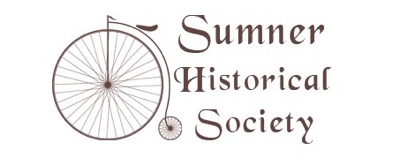
©2019 SUMNER HISTORICAL SOCIETY
1228 MAIN STREET SUMNER WASHINGTON 98390 253-299-5780

Main Street in the 1890's was quite different from the Main Street of today. There may have been just as much activity, though of a different sort. Wagons drawn slowly along, sometimes runaways, teams tied to the hitching racks in front of the livery stable or the blacksmith shop after the horses were given a drink from the watering troughs.
Main Street was so muddy that the Herald says, Feb. 27, 1891, "The planking of about three blocks of the business section of Main Street would prove a great convenience.
In June 1890, quote: "G. H. Ryan has for some time past had in contemplation the erection of a fine two-story brick building on his property east of Rewey's hardware store on Main Street. Monday we were shown plans by Charles Lowe, the architect and contractor. We predict it will be one of the handsomest structures in the valley.
"Twill be 50 x 60 feet with front elevation 35 feet. There will be three store rooms on the first floor 18.6 x 50, 20 x 50 and 20 x 50. A bank room 19 x 50 will occupy the SE corner. There will be a stairway in the center six feet wide leading to a hallway six feet wide on the second floor running the length of the building.
"In the NW corner of the second floor will be the Masonic Lodge room 32 x 36. In the SW three offices 11.6 x 19.6, 19.6 x 10.6 and 12 x 19.6. An office in the center will be 19 x 10 and one in east end 14 x 15. The front will be glass and brick with galvanized cornice. Work has begun and home concerns will furnish all except glass and hardware.
"This building will mark a new era in Sumner as all buildings before this have been constructed of lumber. Now what we need is a first class hotel open to the traveling public. A stock company should be organized to get us a hotel."
Calamity strikes the business district.
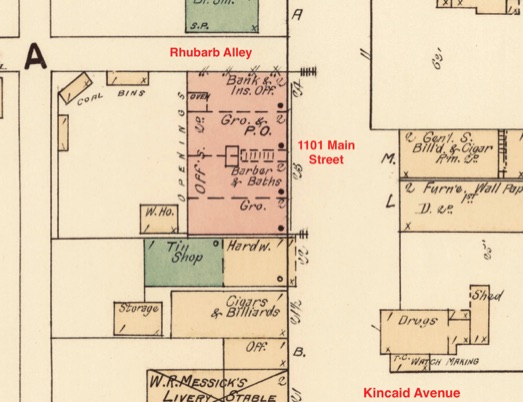
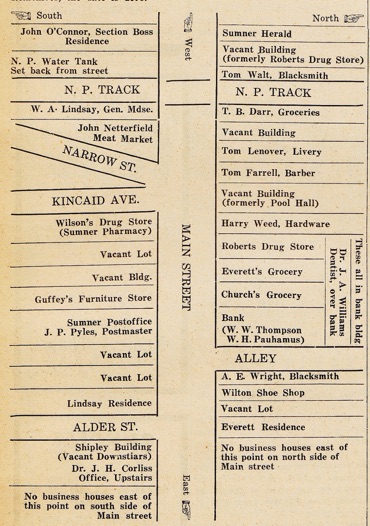
Dr. Corliss Article and map of Sumner in 1983,
Sumner New Index, 1930s, Sumner Historical Society
1891 Sandborn Fire map, Library of Congress and Sumner Historical Society
Amy Ryan's book, The Sumner Story, tells us about George Ryan's first commercial building on Main Street, most of her material came from articles in the 1890s Sumner Herald.
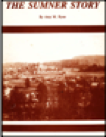
The Sumner Story
The History of Sumner by Amy M. Ryan
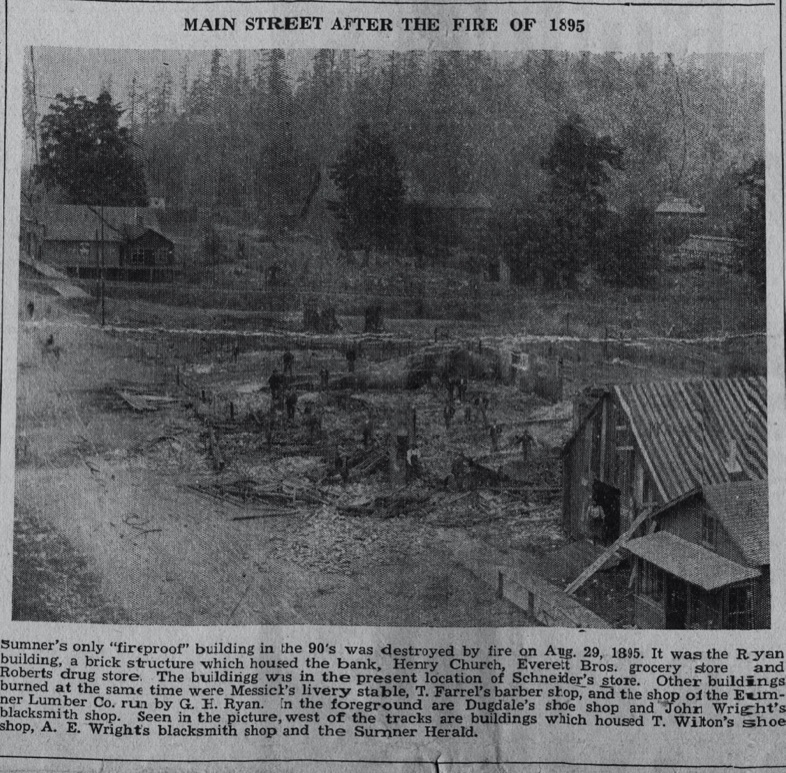
By Amy Ryan
(shortened for brevity)
Work began July 25, 1890. The brick was furnished by Springview Brick and Tile Co., the lumber by the Sumner Lumber Company, mill work by F. W. More Manufacturing Company. This brick was the first made by the new firm in their kiln.
By the first of 1891 the offices were filled by the following: Sumner Lumber, Light and Water Co; the bank which had been incorporated the first of the year by W. L. and F. E. Thompson and E. C. Meade with a capital of $25,000, Will Thompson, president, E. C. Meade, vice president, W. H. Paulhamus, cashier, and Fred Thompson, secretary.
The vault was large and fireproof with a burglar-proof safe with a time clock, all of which gave the community confidence in the new bank, and made it worthy of patronage. (They paid $30 a month rent):
The post office under T. B. Darr paid $25; the barber, W. R. Messick, paid $25; Bergman, for his store, $25; Dr. Stafford. $10; Driskell $10; dentist Williams $5; while the city council had free use of a room. It is interesting to note in an old bookkeeping book which ones were marked "paid!"
However, in 1895, Aug. 30, an account is given of the terrible fire which swept the north side of Main Street and wiped out all of the buildings. Quote: "At 9:30 p.m. fire started in the upper story of the old hardware store and when the alarm sounded (which was the ringing of the church and school bells) in a few minutes over a hundred men had gathered and had begun to fight the flames with water in buckets. The brigade could not reach the upper story but they fought valiantly until the fire department No. 1 from Tacoma, which was sent out on a flat freight car arrived. They pumped water from the NPRR water tank. The old hardware store was dynamited trying to save the other buildings but when it fell it burst into flames and only added to the conflagration. In the meantime the occupants of the stores on the south side of the street were being evacuated, everyone helping to carry out furniture and equipments. Two times the drugstore caught fire as did also the other stores but the flames were extinguished saving the buildings.
"The whole inside of the brick block was ablaze when the wall fell in. If this had not happened the whole town might have gone up in flames, at least the east side. The contents of all buildings were saved though damaged.
"What was the origin of the fire? No one knows. Some thought that a cigaret had fallen down under the wooden sidewalk where some young men had been singing an hour before. But that was ruled out when it was remembered that the fire started in the upper story. The most plausible theory was that a spark from the engine which had passed through at 7:15 had ignited and smoldered until the roof was ablaze. It hardly seemed possible that a tramp had crept up there to sleep and had accidentally started the fire. Many think it was the work of an incendiary. However it might have been worse.
The Tacoma fire department stayed until all flames were extinguished, which was not until morning. B. F. Day, the mayor, had a note of appreciation and thanks to them in the next week's Herald.
A. E. Wright rebuilt his blacksmith shop at once and was ready for business. Henry Church moved a hophouse to the corner and had it made into a store building which was used for many years. Several hophouses were brought to Main Street and fitted for occupancy so stores could function as soon as possible. Main Street had a poor appearance for many years because of the fire.
Nov. 15, 1895, a night watchman was hired to patrol the streets to keep watch so another conflagration would not occur. H. S. Church advertised goods damaged by the fire at special prices.
The burning of Main Street caused many .a heartache not recorded and brought problems that took many years to solve. But the true pioneer spirit made the Sumner business district rise again to serve the community, though she never has had the business that she would have had, had she not been planted between two large cities easy of access.